
Welcome to Antigua and Barbuda
This was my second voyage on the Tenacious. You can see the Tenacious docked just left of center, just lower than center.



I can’t think of a more beautiful place to sail than around Antigua, home of 365 beaches, in the Caribbean. The famous Lord Horatio Nelson was stationed there when he was a younger lad. In the picture above on the right, I’m sitting in area that was once covered and used to service His Majesty’s ships, circa 1780’s – 1800’s.

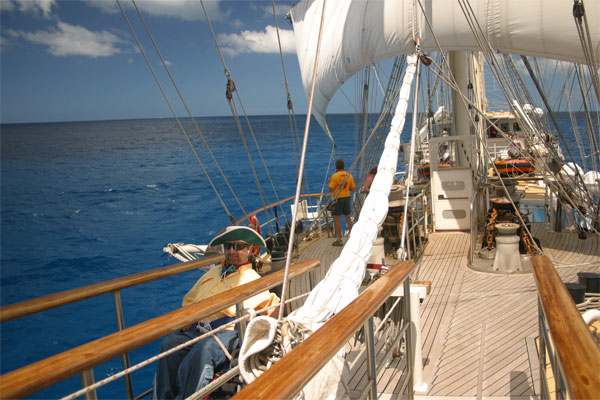
Here I am sitting on the bowsprit. What an incredible view. In the picture on the right you can see the white elevator door just in front of the forward mast.
One of my favorite activities, in addition to sailing while perched on the bowsprit, was to be hauled up the main mast to get a better view of the world. They hauled me up to the crow’s nest where I chilled out for a “photo op.”


The crew of the Tenacious may change from year to year but it is the finest crew with which I have ever had the good fortune to sail. From the Captain to the cook, everyone saw to it that we had a good time. In addition to pure fun, we also had the opportunity to share in the work.
In an all too typical scene on the right, the men had to spend their time supervising the women. Quite frankly, the women would have been lost without us.

Folks in chairs weren’t the only ones to go aloft. When sails had to be reefed, every able bodied soul was sent up the masts and out onto the yards.
In the the picture on the far left you can see Norm in the green hat. He is a WWII Vet from the U.K. He also is blind. You can see in the right hand photo how far up these folks can go. Norm was totally fearless. He said since he couldn’t see he didn’t know how far he could fall.

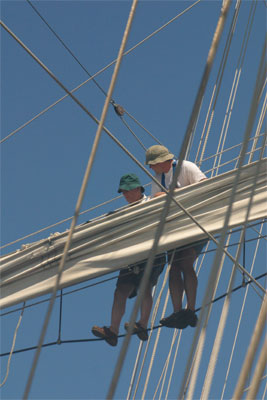
Norm also took his turn steering the ship. The Tenacious is equipped with a talking compass. So even though Norm couldn’t see, he could hear the compass and make steering adjustments accordingly.

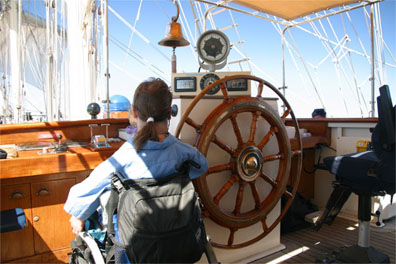
Yours truly also spent time at the helm. Even though I can’t use my hands, I could wrap my fingers around the wheel. On my access page you can see a device for steering that was designed to be used by quads like myself but it was difficult for me to use and I had to have someone hold it or me. I much preferred the method pictured above.
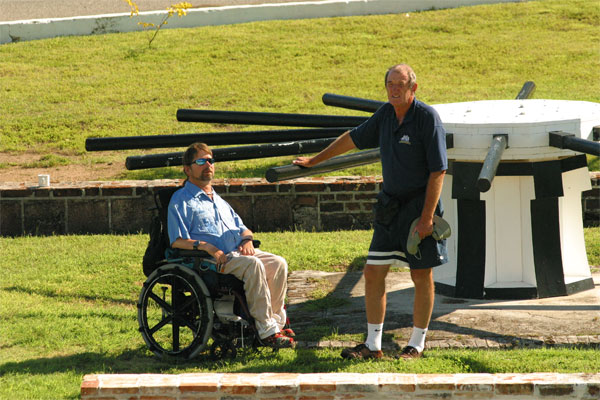

Above left, in Nelson’s Dockyard, Paul gives me the history of these capstans which were each manned by 26 sailors to careen ships to work on the bottom of their hulls. Careen means “to turn a ship on its side for cleaning, caulking, and repairing.” The work done on the bottom of ships began with the removal of barnacles and the shells left by teredo worms, mollusks that infest tropical waters and like to make their home in the wood of a ship’s hull. The buildup reduced a ship’s speed and had to be removed periodically—as often as two or three times a year! A coating of tar, tallow, and sulfur was then applied to discourage their immediate reappearance. On the right, Andy and I show you how the capstans were operated 200 years ago.

That’s me and Brian on an island whose name I can’t remember. Brian is an old friend and savvy traveler. When our voyage was over Brian and I went to the airport only to find the airlines we flew in on no longer operated on Antigua. Brian just took it in stride. We tried, unsuccessfully, to get on another plane that day. We stayed overnight and flew out the next morning. I missed a connecting flight but made it home. Welcome to the world of an Argonaut.


I had to include a picture of Natalie because she’s so photogenic. The picture on the right shows the sea-legs my brother Mike made to keep my chair from flipping over backwards while sailing. My chair held up rather well.
When it did require some maintenance I was lucky enough to have the ship’s engineer take a look at it. I prayed that it was permanently broken and I would have to live the rest of my life aboard the Tenacious but such was not the case.
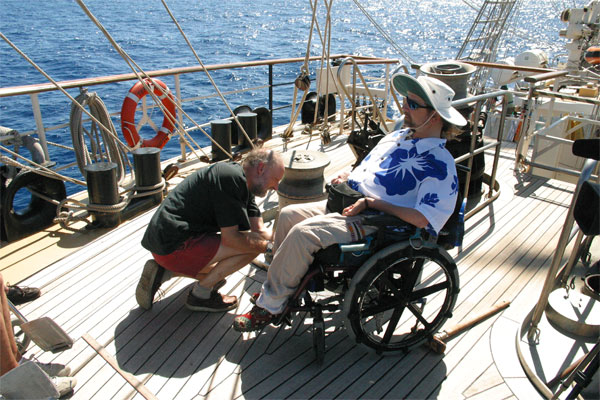

In addition to sailing around Antigua and Barbuda, we sailed around a number of other islands and went ashore on several of them.

We had to anchor offshore of some islands and come ashore on a rubber raft. We were lowered over the side of the ship into the dinghy. As you can see, we stayed in our wheelchairs during the short ride ashore.

Once we got ashore it was fairly easy to get out of the dinghies. It was about that time I thought that maybe it was a good idea that I didn’t bring my electric chair.
We were blessed with incredibly blue skies and water. Each was a different hue and shade of blue like none I’ve ever seen before. The weather was warm and sunny the entire time we were there. We made friends and learned a little about sailing, geography, and culture.
We docked at the Island of Dominica and took a rowboat up the Indian River. They removed some of the seats from the rowboats so we could stay in our chairs. That was very important to me as I have no trunk balance and would easily fall over if I couldn’t sit in my chair. The river was lined with the buttressed Bwa Mang trees.
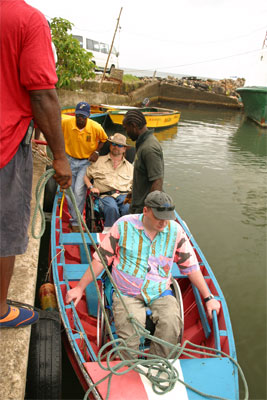

We also saw Ringed Kingfishers. We rowed up the river as far as navigable to a bush bar in the forest, where we disembarked for a refreshment before returning to the ship.
Duncan, front right above, was a shipmate that helped me out on this trip. Cheers Duncan!
This charming lass on the left is one of the few Dominicans. Tourism is a major industry and the native people cater to that industry by selling local crafts including this grasshopper made from – what else – grass. She also made fish and other oddities. We found her at the bush bar in the jungle.

If you would like to sail on a tall-ship, go to www.jst.org.uk/
